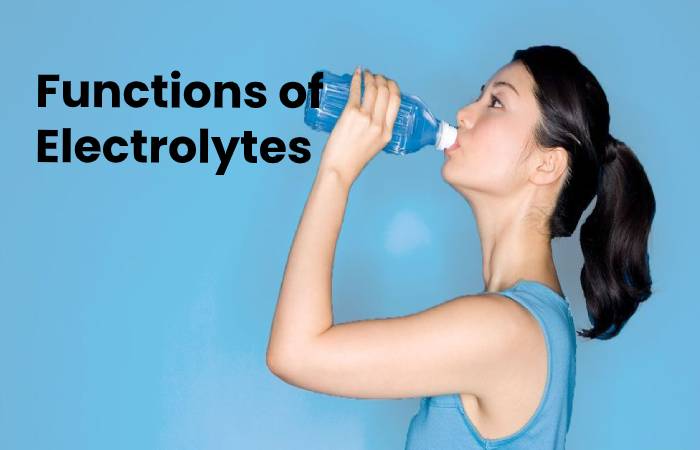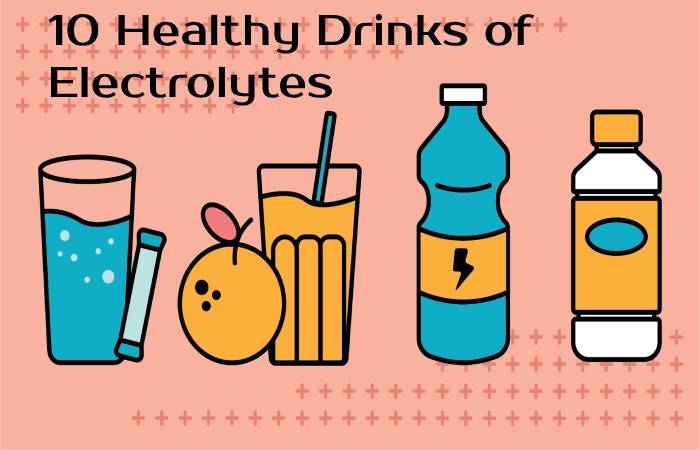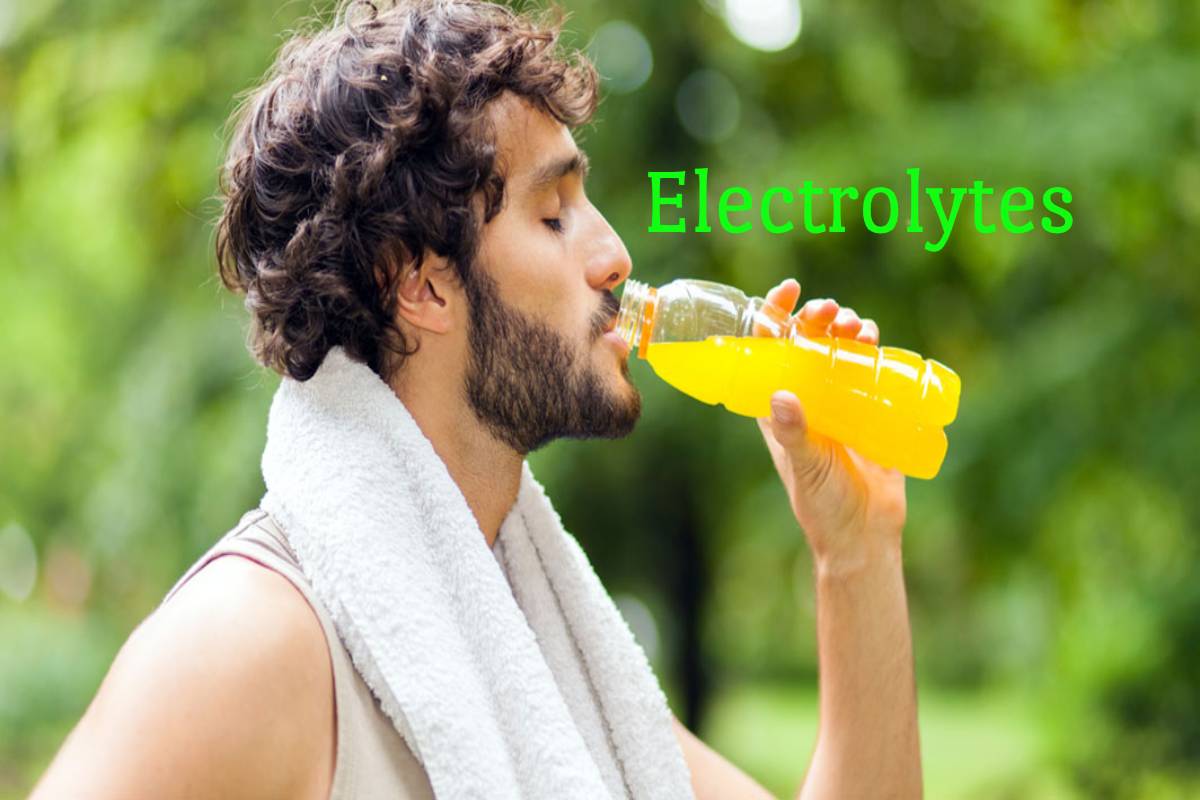Table of Contents
Electrolytes Definition
Electrolytes are a type of essential mineral salts present in our body. Some of the main electrolytes that we also know under the name of “minerals” are potassium, calcium, magnesium, sodium, and bicarbonate.
What are the Functions of Electrolytes?

Among its primary functions, it should note that they regulate muscle functions. It repairs damaged tissues (ideal for accelerating recovery after intense training) and controls the blood’s pH.
They are also responsible for maintaining the proper functioning of the nervous system.
10 Rich Healthy Drinks of Electrolytes

1. Coconut Water
- Coconut water, or coconut juice, is the clear liquid found inside a coconut.
- It has become one of the most popular beverages on the market and is now bottled and sold worldwide.
- Coconut water is naturally low in sugar and contains various electrolytes, including sodium, potassium, calcium, and magnesium.
- At 46 calories per cup (237 ml), it is also a healthier alternative to traditional sodas, juices, and sports drinks.
2. Milk
- When it comes to electrolyte beverages, cow’s milk is an unsung hero.
- Contrary to popular belief, milk can use for much more than breakfast cereals or coffee.
- In addition to its rich supply of electrolytes such as calcium, sodium, and potassium, milk provides a healthy combination of carbohydrates and protein.
- These two macronutrients can help you refuel and promote muscle tissue repair after a workout.
- Since milk’s benefits depend on its electrolyte, carbohydrate, and protein content, you can choose whole, low-fat, or skim milk, depending on your personal preference.
- It’s worth noting that regular cow’s milk may not be the right choice for everyone, especially those who follow a vegan diet or are intolerant to dairy products.
- If you are lactose intolerant but still want to include milk in your workout recovery regimen, opt for a lactose-free version.
- In the meantime, if you are on a vegan diet or have an allergy to milk proteins, you should avoid milk altogether.
- While plant-based alternatives may not offer the same benefits as cow’s milk, some research has shown that soy milk protein can aid muscle repair while providing an electrolyte profile similar to that of soy—cow’s milk.
3. Watermelon Water
- Although the name may suggest otherwise, watermelon water is simply the juice that comes from a watermelon.
- One cup (237 ml) of 100% watermelon juice provides nearly 6% of the Daily Value (DV) for potassium and magnesium while offering small amounts of other electrolytes such as calcium and phosphorous.
- Watermelon juice also contains L-citrulline. When used in supplemental doses, this amino acid can improve oxygen transport and athletic performance.
- However, current research suggests that the amount of L-citrulline in regular watermelon juice is probably not enough to have a measurable effect on exercise performance.
- Other types of fruit juice can also be a good source of electrolytes. For example, tart orange and cherry juice also contain potassium, magnesium, and phosphorus.
- Additionally, 100% fruit juice works as a great source of vitamins and antioxidants.
- One of the main drawbacks of using fruit juice as an electrolyte replacement drink is that it is generally low in sodium.
- If you are sweating for a long time and try to rehydrate with a drink that does not contain sodium, you are at risk of developing low blood sodium levels.
- Some people like to make their own sports drinks with a combination of fruit juices, salt, and water to mitigate this risk.
4. Smoothies
- Shakes are a great way to mix a variety of electrolyte-rich foods into a drinkable concoction.
- Some of the best sources of electrolytes come from whole foods like fruits, vegetables, nuts, seeds, legumes, and dairy products, all of which can mix to make a delicious and nutritious smoothie.
- Suppose you are overcoming a stomach problem and want to replenish lost electrolytes. A shake can be easier to digest and more palatable than many of the foods listed above on their own.
- Shakes are also an excellent option for anyone looking for a post-workout recovery drink. Not only can they replace lost electrolytes, but they’re also a great way to support muscle tissue growth and repair if you include some protein-rich additions.
- However, a shake may not be the best option if you are looking for an electrolyte drink to consume in the middle of intense or prolonged exercise.
- That’s because it has the potential to make you feel too full to complete your workout comfortably. Therefore, it is probably best to reserve it for at least 1 hour before or immediately after your exercise routine.
5. Electrolyte-Infused Water
- Electrolyte-infused water can be a great low-calorie way to replenish electrolytes and stay well hydrated.
- Still, not all electrolyte waters are the same.
- In the United States, most standard tap water contains about 2 to 3% of your daily needs for certain electrolytes, including sodium, calcium, and magnesium.
- Interestingly, specific brands of electrolyte-enhanced bottled water can be costly and do not contain significantly more electrolytes, and in some cases, even less.
- Some brands are specifically designed to help with hydration and mineral replacement and contain higher amounts of electrolytes. They are more likely to be worth your money, depending on why you have an electrolyte drink in the first place.
- Remember that these water types are likely packed with sugar, as many of the designs to replenish carbohydrate stores during prolonged exercise. If you’re not looking for those extra calories from sugar, opt for brands with little or no added sugar.
- You can also try adding freshly cut or crushed fruits and herbs to your water bottle to create your electrolyte-infused flavored water.
6. Electrolyte Tablets
- Electrolyte tablets are a convenient, inexpensive, and portable way to make your electrolyte drink no matter where you are.
- All you have to do is drop one of the tablets into some water and shake or stir to mix.
- Most electrolyte tablets contain sodium, potassium, magnesium, and calcium, although the exact amounts may vary by brand.
- They also tend to be low in calories, have little to no added sugar. And come in various unique fruit flavors.
- Certain brands of electrolyte tablets may also contain caffeine or supplemental doses of vitamins. So be sure to check the label if you want to avoid any of those additional ingredients.
- If you cannot find electrolyte tablets in your area or expect a more affordable price, they are widely available online.
7. Sports Drinks
- Commercially sold sports drinks such as Gatorade and Powerade are among the most popular electrolyte drinks on the market since the 1980s.
- These drinks can be useful for endurance athletes who need a combination of easily digestible carbohydrates, fluids. And electrolytes to maintain hydration and energy during an athletic event or training session.
- However, commercial sports drinks also have some significant drawbacks. They tend to contain any artificial colors, flavors, and added sugars. It is not entirely necessary for anyone, whether you are an athlete or not.
- A 12-ounce (355-ml) serving of Gatorade or Powerade contains more than 20 grams of added sugar. That’s more than half the recommended daily allowance.
- Also, the sugar-free versions may not be a much better alternative.
- Although they do not contain added sugar and are lower in calories, they generally contain sugar alcohols or artificial sweeteners. These sweeteners can contribute to uncomfortable digestive symptoms, such as gas and bloating in some people.
- An easy way to avoid the less right ingredients in sports drinks is to make your own.
- Just use a combination of 100% fruit juice, coconut water, and a pinch of salt to create a healthier electrolyte drink without artificial ingredients and added sugar.
8. Pedialyte
- Pedialyte is a commercial electrolyte drink marketed for children but can also use by adults.
- It designs to be a rehydration supplement when you experience a fluid loss due to diarrhea or vomiting.
- It has much less sugar than a typical sports drink, and sodium, chloride, and potassium are the only electrolytes it contains.
- Each variety contains only 9 grams of sugar, but the flavored options also contain artificial sweeteners. If you want to avoid artificial sweeteners, go for an unflavored version.
9. Salt Water
- Something as simple as salted water can help you replenish electrolytes after exercise. And you don’t need great skill in the kitchen to prepare it.
- It would help if you had a big glass of water and a pinch of salt.
10. Fruit Drink
Suppose you want something more complete. You can prepare a healthy smoothie with some of your favorite citrus fruits, such as orange and lemon.
Ingredients
- 1/2 glass of freshly squeezed lemon juice
- 1/2 glass of freshly squeezed orange juice
- 1 glass of water or 1 glass of coconut water
- 1 pinch of salt
Preparation
- You have to pour all the ingredients into a large jug, stir and drink whenever you want. You can also beat it with the mixer to mix better, and acquires a texture with a little more body.
- These are some options for drinks with electrolytes to prepare yourself comfortably from home and without much complication.
- In addition to these homemade options, at Myprotein. We have an electrolyte supplement that will help you replace them after intense exercise.
- It is also available in delicious flavors for you to enjoy while taking care of your body in the best way.
- Therefore, remember that after practicing intense exercise, whether with weights, running, swimming, with your weight, etc.
- You must replenish your electrolyte levels to enjoy optimal recovery and maintain your health at maximum.
Is an Electrolytes Drink Right for You?
- Sports drinks and other types of electrolyte drinks are often marketed to the general public but are probably unnecessary for most people.
- Regular intake of some high-calorie, high-sugar electrolyte drinks could make it difficult for you to reach your health goals, mainly if they do not use for their intended purpose.
- Most healthy, moderately active people can stay hydrated and get adequate electrolytes by eating a balanced, nutrient-rich diet and drinking plenty of water.
- Fluid needs can vary by individual, but it generally recommends consuming at least 68 to 101 ounces (2 to 3 liters) of fluid per day from a combination of food and drink.
- That said, there are specific cases where you may be at a higher risk of dehydration, and simple food and water are not enough.
- Suppose you engage in vigorous and continuous physical activity for more than 60 minutes. It spends prolonged periods in a scorching environment or has diarrhea or vomiting; you may need an electrolyte drink.
- If you’re not sure whether you’re hydrating properly, watch for these signs of mild to moderate dehydration:
- Dry mouth and tongue
- Thirst
- Lethargy
- Dry Skin
- Muscular weakness
- Dizziness
- Dark urine
8. Suppose you experience any of these symptoms and are consuming adequate fluids. It may be time to add an electrolyte drink to your routine. If these symptoms get worse, see your healthcare provider.
Conclusion
Electrolytes are minerals that help your body perform various vital functions, such as hydration, muscle contractions, pH balancing, and nerve signaling. It functions correctly; your body must maintain adequate fluid and electrolyte levels at all times.
Drinks like coconut water, milk, fruit juice, and sports drinks can help hydrate and balance electrolytes. For most people, a balanced diet and adequate water intake are sufficient to maintain electrolyte levels.
However, some cases may warrant the use of electrolyte beverages, especially if you are experiencing rapid fluid losses due to sweating or illness.
Drinking plenty of water and watching out for the first signs of dehydration can help you determine whether adding an electrolyte drink to your routine is right for you And also you can watch this movie kaisi yeh yaariaan
Also Read: Fatty Liver- Definition, Symptoms, 14 Foods To Reverse, and More

